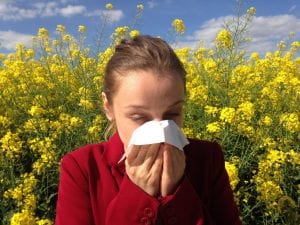Functional Nutritionist’s Recommendations to Calm Histamine Intolerance
 Most of us know about anti-histamines. We take them to relieve our itchy eyes and runny noses during “allergy season.” We might take them to be able to breathe around a beloved pet. Or we might use them for minor emergencies such as bee stings.
Most of us know about anti-histamines. We take them to relieve our itchy eyes and runny noses during “allergy season.” We might take them to be able to breathe around a beloved pet. Or we might use them for minor emergencies such as bee stings.
All of these allergic reactions are because of histamines — that word we may not really even think of!
So, what is histamine? Is it running through our bodies creating trouble? If so, then are antihistamines the heroes — the posse rounding up the bad guys?
Of course, it is not as simple as black and white. 
Yes, histamine is part of the inflammation response. Yes, it is released in response to an injury or allergic reaction. However, histamine is an important neurotransmitter in our bodies. It helps with circadian rhythms of sleep and wake cycles, helps regulate blood pressure, plays a role in digestion, and much more.
Histamine Intolerance Is More Complicated Than Runny Noses, Sneezes and Itchy Eyes
Symptoms can vary widely. Some people may not be able to go to sleep. Some may have digestive issues. According to Bob Miller of the MethylGenetic Research Institute, others may even have irregular menstrual cycles, infertility or heart arrhythmias. Here is a list of common symptoms of histamine intolerance from Mind Body Green:
- Headaches/migraines
- Difficulty falling asleep, easy arousal
- Hypertension
- Vertigo or dizziness
- Arrhythmia, or accelerated heart rate
- Difficulty regulating body temperature
- Anxiety
- Nausea, vomiting
- Abdominal cramps
- Flushing
- Nasal congestion, sneezing, difficulty breathing
- Abnormal menstrual cycle
- Hives
- Fatigue
- Tissue swelling
Histamine may become more of a problem if you have leaky gut or if you have poor ABP1 gene function. The ABP1 gene creates the DAO enzyme that breaks down histamine in the intestinal tract. This is one reason that some people have problems with red wine, but not other foods that are high in histamines. (If you are a wine drinker, you might want to read this post on DrinkPureWine.com.)
Does your nose begin to drip, do your eyes itch or do you sneeze when eating dried meats such as pepperoni? Or when you drink beer or wine? This is a sign of histamine intolerance. Fermented foods such as yogurt, cheese and vinegars can also be a problem if you have histamine intolerance. Even eating leftovers can contribute to your symptoms as the longer the time between preparing the meal and eating it, the higher the histamine level in that food!
What Is Behind Your Running Nose?
 For your optimum health, it is important to determine what is causing your intolerance to high-histamine foods.
For your optimum health, it is important to determine what is causing your intolerance to high-histamine foods.
A thorough dietary intake and health history often provides you and your functional nutritionist with clues. It may become clear that you have a problem every time you have that healthy salad dressed in EVOO and balsamic vinegar — and who would have thought that was the cause of your breathing issues!
You can also test for histamine intolerance in two ways. First, the NutriGenetic Research Institute offers an epigenetic test that reveals your body’s ability to break down histamines in the digestive tract and in the body via the ABP1 gene and the HNMT gene, respectively. Another test gives you a ratio of histamine to DAO enzyme levels in the body.
Once you’ve determined that high histamine is contributing to your symptoms, you address in it a multifactorial way:
- Eat a low-histamine diet
- Take a supplement with a DAO enzyme
- Maximize gut health
Once gut health has improved and histamine levels reduced, you can begin adding back high-histamine foods. You’ll want to keep a record to know which foods you continue to react to, and you’ll want to reintroduce foods one at a time, so you can clearly identify the culprits. Over time, it is likely that you will be able to add several foods back into your diet. After all, the ultimate goal is to have as wide a variety of foods in your diet as possible.
Word of caution: I encourage you not to attempt to eliminate all histamine foods. All foods have some level of histamines. Trying to get rid of them all will drive you crazy, not to mention it will be severely limiting for no added benefit.
Low-Histamine Diet Recommendations for Improved Health
Foods to eat for the next 6 weeks:
- Fresh meats, chicken, fish (or flash-frozen), eggs
- Gluten-free grains such as rice, millet, amaranth, quinoa
- A wide variety of vegetables (except tomatoes, spinach, avocados and eggplant)
- Mango, pear, apples, grapes, melons, kiwi, pomegranate
- Dairy substitutes
- Olive oil for dressing vegetables after cooking or for dressing salads
- Coconut oil for cooking
- Herbs such as cilantro, parsley, basil, oregano, thyme, rosemary
- Herbal teas
Once you’ve eaten a low-histamine diet for 6 weeks, you can begin to add in some of your favorite high-histamine foods, such as nuts or avocados, to see how you react.
By keeping a log of what you eat and how you feel after eating (immediately and for several hours), you may discover there are some foods that cause a strong reaction. In that case, you will want to leave those items out of your diet.
Give our office a call if you want personalized guidance on your low-histamine diet or information on testing for histamine intolerance.

